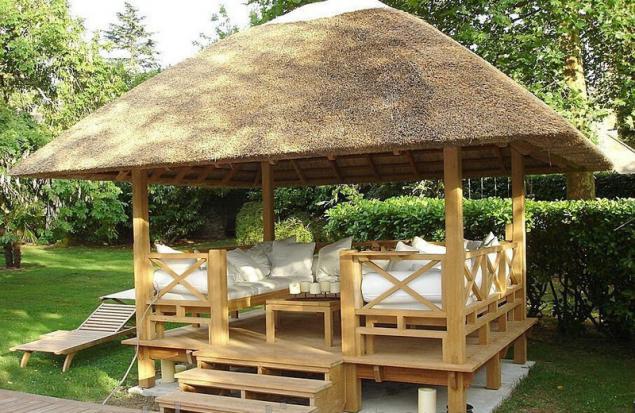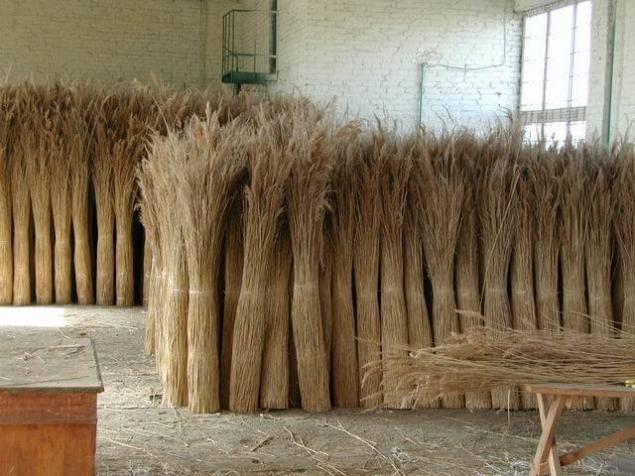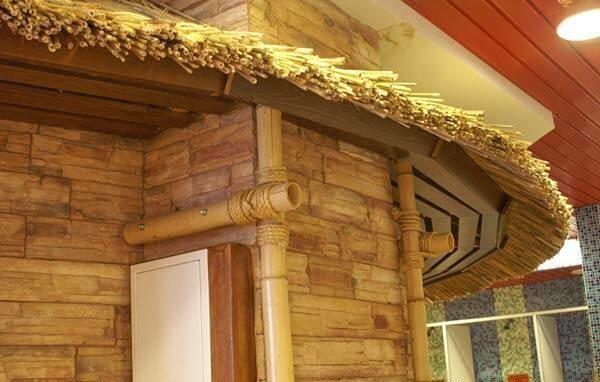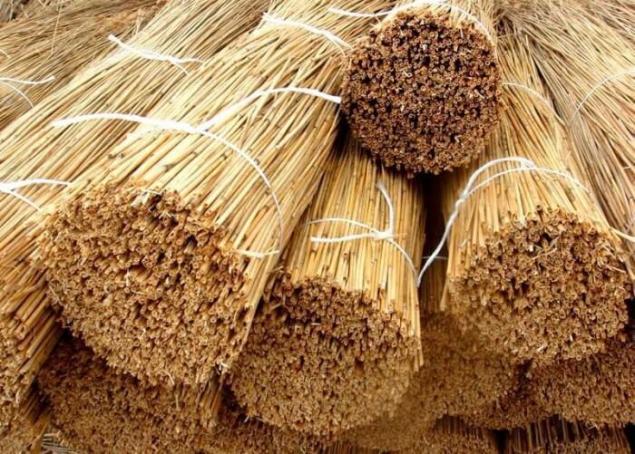1294
The roof of reeds for its environmentally friendly and beautifully rukami-
Thatched roof was used in order to cover their homes from the time when the population of the planet was not aware of the gland. Over the last century there has been active development of all spheres of human activity. As a result, the roof of reeds was forgotten and replaced by a coating of roofing material in the beginning, and then galvanized steel, slate sheets and trapezoidal sheet.

In any case, reed is the most eco-friendly material for roofing. It is necessary to pay tribute to the activities of the owner of the commercial companies managing living rooms, restaurants, cafes and other establishments that have a country-style interior. From them comes the idea of the return of original and beautiful thatched roof.
Currently, demand for reed roof is constantly growing. The reasons for this lie in the unique appearance of the entire structure as a whole, the ability to diversify the range of the same type of materials for roofing. Such a roof can easily be done independently, and this, in turn, will make more beautiful building erected, allowing both to save on the cost of materials.
Most often you can see a thatched roof on a variety of cafes, saunas, hotels and inns. But the use of such a roof for the construction of residential house is not so widespread because of the high cost and the risk that they might ignite.
To increase the degree of fire resistance, ready to have a thatched roof is processed using flame retardants. However, it should be borne in mind that due to the fact that the penetration depth is small, the composition can be flushed sediment for several years and needs periodic updating.
Material properties for thatched roofs

Along with the original rushes are the following remarkable qualities:
a high degree of resilience to the vagaries of nature (heat, torrential rain, frost, wind);
the ability to create complex shapes of the roof due to the flexibility of cane stalks);
resistance to mold and mildew, because reeds high humidity is the natural environment;
available natural ventilation thanks to the tight fit of dry stalks with a hollow structure in large quantities;
ideal protection reed houses by the tubular structure;
low thermal conductivity levels, so you can not use additional materials for insulation;
no need to use materials for the regeneration of the roof waterproofing;
the durability of the roof, as the service life of such a roof can reach up to 60 years or more, with no need for cleaning, tinting, and insulation of the roof.
Today, with the roof of reeds covered considered very original and refined element of decoration of buildings and structures. In the initial period from cane is a golden color, which over time becomes more saturated, that ennobles the facade of the house and the surrounding land.
The advantages of using a reed roof

Currently, to cover the roofs on barns, gazebos, restaurants, saunas and mini-hotels settling reed roof, and this trend is increasingly growing. However, this material has not yet won the confidence of a sufficiently large as in the application of this material there is a danger of ignition roof. But this will not happen if the roof of reeds undeveloped own hands with all the modern fire safety precautions.
Often, many make the mistake of thinking that the fire protection processing is subject to the stems of reeds, but actually handled the finished roofing. Fire-retardant mixture penetrates to 5 centimeters, but after a few years, she washed. Advantages of reed cover is very impressive. They are as follows:
In western European countries because of the special relationship to the environmental issues are not using fire protection roof of reeds as important for Europeans to be used as the material for the roof of reeds was absolutely harmless, and it is quite reasonable choice.
Compared with the currently popular roofs, roof, self-woven of reeds in the summer cools the roof space, and in the winter, on the contrary, warms.
No need to worry about installing waterproofing layers, vapor barriers and insulation, as the leaves and stems of reeds to prevent the appearance of condensation and have low thermal conductivity. These properties reduce costs earmarked for the construction of buildings as a whole.
Reed is a material having excellent sound insulation, so that the roof will not hear the outside noise outside, knocking rain, hail or wind roar.
Since the reed roof is not a source for the accumulation of static electricity, the probability of a lightning strike on the thatched roof is very low.
No need to repair these roofs, their cleaning and painting over 50-60 years. If you want to carry out repair work, replacing a patch whose color after about a year will be slightly different from the general color of the roof.
In reed roof appearance after a certain time becomes usually brighter and more favorable, thereby contributing to the harmonious combination of the building and the surrounding landscape.
Rectification
thatched roof
Along with the advantages of reed roof there are also disadvantages. However, it is possible to fight with them in various ways, among which the following are known:
Material thatched roof easily burns. In order to protect the roof from this, there are various techniques for processing the roof comprising impregnating cane stalks through refractory compositions with qualities. Thus reed material and must be treated on the outside and inside. Such a coating is removed sediments of various kinds.
Roof of reeds may annoy the birds based on natural reasons, because their stems for feathered creatures are remarkable building material in the regeneration of the nests. In order to protect the stems from the stripping birds from the roof, they must be well compacted so that a dense planned roof is not sticking out the ends.
Despite the presence of small flaws, which even can be called a rather inconvenience mansard roof of reeds at the expense of its quality material will last for a long time and with confidence. The main thing, installing it, follow all the rules and how to prepare for the construction of the base of the crates.
It should be noted that at the household level, there is a misconception that a cane can be a cozy place to where bred rodents. However, in fact last longer prefer the system tiles and flame retardants processed cane is not a secluded place for their stay.
Features of the device roof of reeds
When the device thatched roof should be aware of the following features:
of roof slope should be not less than 35 degrees;
because of the large thickness of the roof (about 30 centimeters) execution pipeline to the roof is not possible, for it is recommended by the roof perimeter to create a drainage layer, collecting and discharging water to the storm sewer, or rainwater flows quickly lead blind area in unsuitable, spoiling the appearance of the facade < br> If the house has a wood stove or fireplace, the roof must be protected from sparks;
the house should be located in an open area to ensure reeds "breath" and access to the sun, or shade and falling leaves will contribute to the gradual accumulation of moisture in the reeds, and this in turn will shorten the life of a thatched roof.
The choice of material

Choosing the reeds for the roof, you should pay attention to the following details:
in reed leaves should not be;
color reeds should be smooth and free from mold burnt spots;
there should be no foreign matter, such as grass and other plants.
It is also necessary to determine the shape of the material, which is the most suitable device for the roof: Producers presented the following two kinds:
Sheaves, representing approximately 50 associated in a bunch of stems, the length of which is not more than two meters. The cost of a roof of reeds, which were used for the construction of reed bundles, along with the installation work will be sufficiently high, namely, about $ 100 per square meter.
The mats constituting the reed stems, which are linked in the form of mats, the thickness of which is 15 centimeters. As the cost of the mats cheaper than the sheaves, and they are easier to use in the work.
Methods of laying a thatched roof
In accordance with their preferences homeowners can choose from the many existing ways of styling. Under the arrangement is meant every way beams of material overlap with the subsequent fixing with stainless steel wire, using the middle of the beam clamp fixing.
The difference in the methods of stacking is usually used in the length of stems in their packing densities and clearance approaches to the roof. Thus, for example, Danish technology using respective stems with a meter and a thickness of about 5 millimeters in length. According to Dutch technology used longer stems, length 1, 8 m, and even more dense packing than using Polish technology. Making horse on the Polish technology, using a cane. In other technologies, this can be used tiles, wood or copper.
Reed roofs are also classified according to the type of packing into the following types:
The open roof, which is the wrong side of the room below the ceiling. This type of roof is mainly used for decoration of buildings (restaurants, cafes). In this type of stowage space inside the jungle can get down, bringing inconvenience.
Closed roof, for which the installation of mats and bundles of produce on a continuous crate, which additionally serves as an insulating layer. This kind of packing is simpler and hence faster.
Laying thatched roof with his hands
In addition to the use of a reed roof for the house, it can also be used in decorative and business support facilities for subsistence farming, as well as for landscape and park architecture. These are gazebos, benches, woodsheds, sheds and more. For those who want to master the unusual skill of laying a thatched roof should begin with similar structures. For this type of art does not need any special talent, but only the desire to learn a trade, the presence of a suitable material and, of course, the roof as an object of focus. If you have the appropriate skills, the master will soon be able to build yourself a roof of reeds with unusual appearance and long service life, while saving a lot on a budget.
Wiring thatched roof
Through the installation of the roof is necessary to adhere to certain rules:
The material for the roof of reeds are separated by parts on long, short, or tough stems. Average long stems are used in the design of the main part of the roof. Short details used on skates, front sections and corners. Well bendable coarse stems used as a substrate inside the roof.
forming reed tufts depending on the size and length of the stem. Stems with a small diameter is used for the initial layer. In general, the crates of one meter takes about 8 beams for total coverage.
In the case where the reeds covered pergolas, the base can be made public. Covering residential construction, the base should be made as a closed-end structure.
Installation thatched roof

Before mounting the stem in metal lath screwed screws needed to secure the wire bent in the middle, made of stainless steel.
Technology laying a thatched roof is in the following items:
Roof installation starts with its bottom. On the basis stack the sheaves associated stalks.
Fixed with screws to the wire is pulled through the stacked sheaves. At the initial stage, a part of the cover, is fixed with steel wire and rods to the crate. These details from a metal coated with a second layer.
Before laying the first layer of reeds set fishing lines and long ladders. It is necessary to depart on a platform two feet from the eaves. Next, move on to the roof roofers.
It is necessary that the thickness increased simultaneously with sealing layer reeds. For the smooth slope of the line type of blade used.
The top of the part beams is set small, to simplify the alignment of the upper layers of material and rows. Top customize using the blade, so that is possible to make a connection subsequent stacking sheaves imperceptible.
To install using the hooks that hold the ends of each ryadya while pridelyvaya the previous layer.
To avoid the appearance of visually noticeable furrows and lines that contribute to water flow should increase the indent on the approach to the ridge stacking. Ridge beam must protect the roof from leaking various precipitation being cool aimed to lay the last layer.
Sheaves must be pre-soak and put out to dry on the ridge to lock in the proper form.
Then, for the practical application and beauty ridged stems covered copper, or a ceramic material.
On the bulge area stem spend trimming.
For reed roof technology also provides purification and rapping thatched roof. In order to accomplish this rather tedious phase of attracting qualified employees, who have the necessary tool kits.
For any known technologies thatched roof stowage require mandatory alignment, which use a special blade to firmly drive leaves into sheaves and joints and align the bevels of each row. Reed roof, thus visually acquires the traditional look. If desired, after completion of the laying of reeds roofing treated with fire-retardant formulations. However, such treatment can not be carried out, since the roof of reeds are stacked tightly layers, which reduces the possibility of fire, which is just as likely as any other type of roof.
roof coverings Cost reeds
The construction of the roof of reeds, usually involves quite substantial costs, which include the following:
work of professional handlers working by hand;
absolutely harmless and unique material;
Storing complex procedure.
Cane is harvested in autumn and winter at the end of its ripening, after which the plant falls into hibernation. Conducted workpiece manually or with special machines, but it does not affect the cost of the cane.
For example, the cost of the roof of reeds in Europe is around 200 euros, and in the Russian Federation, the price per square meter is about 70-130 euros.
Reed roof is safe and long, without requiring any additional investment. Roofs made of reed is environmentally friendly way to ensure the comfort of home, warm and attractive unusual appearance.
Without a doubt, installation specialists roof of reeds provide guarantees their work done, but it is possible to arrange it on your own in-house, respecting the required installation conditions and demonstrating a responsible approach to work, reed roof can bring to the perception of the site and area as a whole an unusual flavor. Thatched roof house or garden will surpass all expectations with its beauty owners.

In any case, reed is the most eco-friendly material for roofing. It is necessary to pay tribute to the activities of the owner of the commercial companies managing living rooms, restaurants, cafes and other establishments that have a country-style interior. From them comes the idea of the return of original and beautiful thatched roof.
Currently, demand for reed roof is constantly growing. The reasons for this lie in the unique appearance of the entire structure as a whole, the ability to diversify the range of the same type of materials for roofing. Such a roof can easily be done independently, and this, in turn, will make more beautiful building erected, allowing both to save on the cost of materials.
Most often you can see a thatched roof on a variety of cafes, saunas, hotels and inns. But the use of such a roof for the construction of residential house is not so widespread because of the high cost and the risk that they might ignite.
To increase the degree of fire resistance, ready to have a thatched roof is processed using flame retardants. However, it should be borne in mind that due to the fact that the penetration depth is small, the composition can be flushed sediment for several years and needs periodic updating.
Material properties for thatched roofs

Along with the original rushes are the following remarkable qualities:
a high degree of resilience to the vagaries of nature (heat, torrential rain, frost, wind);
the ability to create complex shapes of the roof due to the flexibility of cane stalks);
resistance to mold and mildew, because reeds high humidity is the natural environment;
available natural ventilation thanks to the tight fit of dry stalks with a hollow structure in large quantities;
ideal protection reed houses by the tubular structure;
low thermal conductivity levels, so you can not use additional materials for insulation;
no need to use materials for the regeneration of the roof waterproofing;
the durability of the roof, as the service life of such a roof can reach up to 60 years or more, with no need for cleaning, tinting, and insulation of the roof.
Today, with the roof of reeds covered considered very original and refined element of decoration of buildings and structures. In the initial period from cane is a golden color, which over time becomes more saturated, that ennobles the facade of the house and the surrounding land.
The advantages of using a reed roof

Currently, to cover the roofs on barns, gazebos, restaurants, saunas and mini-hotels settling reed roof, and this trend is increasingly growing. However, this material has not yet won the confidence of a sufficiently large as in the application of this material there is a danger of ignition roof. But this will not happen if the roof of reeds undeveloped own hands with all the modern fire safety precautions.
Often, many make the mistake of thinking that the fire protection processing is subject to the stems of reeds, but actually handled the finished roofing. Fire-retardant mixture penetrates to 5 centimeters, but after a few years, she washed. Advantages of reed cover is very impressive. They are as follows:
In western European countries because of the special relationship to the environmental issues are not using fire protection roof of reeds as important for Europeans to be used as the material for the roof of reeds was absolutely harmless, and it is quite reasonable choice.
Compared with the currently popular roofs, roof, self-woven of reeds in the summer cools the roof space, and in the winter, on the contrary, warms.
No need to worry about installing waterproofing layers, vapor barriers and insulation, as the leaves and stems of reeds to prevent the appearance of condensation and have low thermal conductivity. These properties reduce costs earmarked for the construction of buildings as a whole.
Reed is a material having excellent sound insulation, so that the roof will not hear the outside noise outside, knocking rain, hail or wind roar.
Since the reed roof is not a source for the accumulation of static electricity, the probability of a lightning strike on the thatched roof is very low.
No need to repair these roofs, their cleaning and painting over 50-60 years. If you want to carry out repair work, replacing a patch whose color after about a year will be slightly different from the general color of the roof.
In reed roof appearance after a certain time becomes usually brighter and more favorable, thereby contributing to the harmonious combination of the building and the surrounding landscape.
Rectification
thatched roof

Along with the advantages of reed roof there are also disadvantages. However, it is possible to fight with them in various ways, among which the following are known:
Material thatched roof easily burns. In order to protect the roof from this, there are various techniques for processing the roof comprising impregnating cane stalks through refractory compositions with qualities. Thus reed material and must be treated on the outside and inside. Such a coating is removed sediments of various kinds.
Roof of reeds may annoy the birds based on natural reasons, because their stems for feathered creatures are remarkable building material in the regeneration of the nests. In order to protect the stems from the stripping birds from the roof, they must be well compacted so that a dense planned roof is not sticking out the ends.
Despite the presence of small flaws, which even can be called a rather inconvenience mansard roof of reeds at the expense of its quality material will last for a long time and with confidence. The main thing, installing it, follow all the rules and how to prepare for the construction of the base of the crates.
It should be noted that at the household level, there is a misconception that a cane can be a cozy place to where bred rodents. However, in fact last longer prefer the system tiles and flame retardants processed cane is not a secluded place for their stay.
Features of the device roof of reeds
When the device thatched roof should be aware of the following features:
of roof slope should be not less than 35 degrees;
because of the large thickness of the roof (about 30 centimeters) execution pipeline to the roof is not possible, for it is recommended by the roof perimeter to create a drainage layer, collecting and discharging water to the storm sewer, or rainwater flows quickly lead blind area in unsuitable, spoiling the appearance of the facade < br> If the house has a wood stove or fireplace, the roof must be protected from sparks;
the house should be located in an open area to ensure reeds "breath" and access to the sun, or shade and falling leaves will contribute to the gradual accumulation of moisture in the reeds, and this in turn will shorten the life of a thatched roof.
The choice of material

Choosing the reeds for the roof, you should pay attention to the following details:
in reed leaves should not be;
color reeds should be smooth and free from mold burnt spots;
there should be no foreign matter, such as grass and other plants.
It is also necessary to determine the shape of the material, which is the most suitable device for the roof: Producers presented the following two kinds:
Sheaves, representing approximately 50 associated in a bunch of stems, the length of which is not more than two meters. The cost of a roof of reeds, which were used for the construction of reed bundles, along with the installation work will be sufficiently high, namely, about $ 100 per square meter.
The mats constituting the reed stems, which are linked in the form of mats, the thickness of which is 15 centimeters. As the cost of the mats cheaper than the sheaves, and they are easier to use in the work.
Methods of laying a thatched roof
In accordance with their preferences homeowners can choose from the many existing ways of styling. Under the arrangement is meant every way beams of material overlap with the subsequent fixing with stainless steel wire, using the middle of the beam clamp fixing.
The difference in the methods of stacking is usually used in the length of stems in their packing densities and clearance approaches to the roof. Thus, for example, Danish technology using respective stems with a meter and a thickness of about 5 millimeters in length. According to Dutch technology used longer stems, length 1, 8 m, and even more dense packing than using Polish technology. Making horse on the Polish technology, using a cane. In other technologies, this can be used tiles, wood or copper.
Reed roofs are also classified according to the type of packing into the following types:
The open roof, which is the wrong side of the room below the ceiling. This type of roof is mainly used for decoration of buildings (restaurants, cafes). In this type of stowage space inside the jungle can get down, bringing inconvenience.
Closed roof, for which the installation of mats and bundles of produce on a continuous crate, which additionally serves as an insulating layer. This kind of packing is simpler and hence faster.
Laying thatched roof with his hands
In addition to the use of a reed roof for the house, it can also be used in decorative and business support facilities for subsistence farming, as well as for landscape and park architecture. These are gazebos, benches, woodsheds, sheds and more. For those who want to master the unusual skill of laying a thatched roof should begin with similar structures. For this type of art does not need any special talent, but only the desire to learn a trade, the presence of a suitable material and, of course, the roof as an object of focus. If you have the appropriate skills, the master will soon be able to build yourself a roof of reeds with unusual appearance and long service life, while saving a lot on a budget.
Wiring thatched roof
Through the installation of the roof is necessary to adhere to certain rules:
The material for the roof of reeds are separated by parts on long, short, or tough stems. Average long stems are used in the design of the main part of the roof. Short details used on skates, front sections and corners. Well bendable coarse stems used as a substrate inside the roof.
forming reed tufts depending on the size and length of the stem. Stems with a small diameter is used for the initial layer. In general, the crates of one meter takes about 8 beams for total coverage.
In the case where the reeds covered pergolas, the base can be made public. Covering residential construction, the base should be made as a closed-end structure.
Installation thatched roof

Before mounting the stem in metal lath screwed screws needed to secure the wire bent in the middle, made of stainless steel.
Technology laying a thatched roof is in the following items:
Roof installation starts with its bottom. On the basis stack the sheaves associated stalks.
Fixed with screws to the wire is pulled through the stacked sheaves. At the initial stage, a part of the cover, is fixed with steel wire and rods to the crate. These details from a metal coated with a second layer.
Before laying the first layer of reeds set fishing lines and long ladders. It is necessary to depart on a platform two feet from the eaves. Next, move on to the roof roofers.
It is necessary that the thickness increased simultaneously with sealing layer reeds. For the smooth slope of the line type of blade used.
The top of the part beams is set small, to simplify the alignment of the upper layers of material and rows. Top customize using the blade, so that is possible to make a connection subsequent stacking sheaves imperceptible.
To install using the hooks that hold the ends of each ryadya while pridelyvaya the previous layer.
To avoid the appearance of visually noticeable furrows and lines that contribute to water flow should increase the indent on the approach to the ridge stacking. Ridge beam must protect the roof from leaking various precipitation being cool aimed to lay the last layer.
Sheaves must be pre-soak and put out to dry on the ridge to lock in the proper form.
Then, for the practical application and beauty ridged stems covered copper, or a ceramic material.
On the bulge area stem spend trimming.
For reed roof technology also provides purification and rapping thatched roof. In order to accomplish this rather tedious phase of attracting qualified employees, who have the necessary tool kits.
For any known technologies thatched roof stowage require mandatory alignment, which use a special blade to firmly drive leaves into sheaves and joints and align the bevels of each row. Reed roof, thus visually acquires the traditional look. If desired, after completion of the laying of reeds roofing treated with fire-retardant formulations. However, such treatment can not be carried out, since the roof of reeds are stacked tightly layers, which reduces the possibility of fire, which is just as likely as any other type of roof.
roof coverings Cost reeds
The construction of the roof of reeds, usually involves quite substantial costs, which include the following:
work of professional handlers working by hand;
absolutely harmless and unique material;
Storing complex procedure.
Cane is harvested in autumn and winter at the end of its ripening, after which the plant falls into hibernation. Conducted workpiece manually or with special machines, but it does not affect the cost of the cane.
For example, the cost of the roof of reeds in Europe is around 200 euros, and in the Russian Federation, the price per square meter is about 70-130 euros.
Reed roof is safe and long, without requiring any additional investment. Roofs made of reed is environmentally friendly way to ensure the comfort of home, warm and attractive unusual appearance.
Without a doubt, installation specialists roof of reeds provide guarantees their work done, but it is possible to arrange it on your own in-house, respecting the required installation conditions and demonstrating a responsible approach to work, reed roof can bring to the perception of the site and area as a whole an unusual flavor. Thatched roof house or garden will surpass all expectations with its beauty owners.
In the Netherlands, building a network of charging stations with solar panels
Integrated security object























